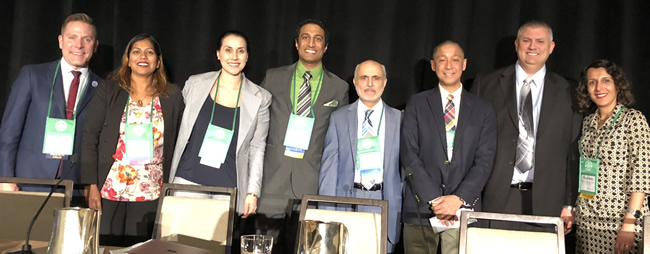Meeting Reviews
Chronic Pain and Palliative Care
By Lisgelia Santana, MD, FAAP and Genevieve D'Souza, MD

L-R: R. Scott Dingeman, MD, FAAP; Genevieve D’Souza, MD; Lisqelia Santana-Rojas, MD; Neil Raj Singhal, MD; Navil F. Sethna, MB, ChB; Gerard Banez, PhD; Mark Popenhagen, PhD; Rashmi P. Bhandari, PhD
Neil Raj Singhal, MD reported a case of a female who suffered from headaches and abdominal pain that subsequently spread to the entire body. The pain caused severe dysfunction for this patient. Dr. Singhal consulted his team psychologist, Mark Popenhagen, PsyD, to address significant psychosocial factors and work with the patient on cognitive behavioral therapy and family therapy. The psychologist addressed the importance of how and when to involve psychology and psychiatry in an interdisciplinary approach for better results in pediatric pain patients.
The patient was live on Skype during the session and talked about her experience during the inpatient intensive rehabilitation program at Children’s Hospital of Phoenix. She recognized the importance of a team approach and the support from her family during the process. She was able to finish high school and continue undergraduate studies. It is essential to demonstrate setting realistic goals for patients as well as for the family and to help maximize the odds of successful recovery from amplified pain syndromes.
Rashmi P. Bhandari, PhD presented on a free, open-source, flexible Learning Health System (LHS) (http://choir.stanford.edu). Peds-CHOIR (Pediatric Collaborative Health Outcomes Information Registry) is a comprehensive assessment tool tracking physical, psychological and social functioning for children with chronic pain and global health outcomes for their caregivers. It is a great tool for point of care clinical interventions in the treatment of chronic pediatric pain, and for enhancing research interventions and precision pain medicine. LHS can inform interdisciplinary strategies and progress, and enhance patient-provider collaboration. Peds-CHOIR longitudinally tracks patient and proxy reports of pain, fatigue, mobility, pain interference, anxiety, depression, pain catastrophic thinking, sleep, fear avoidance, parental protective behaviors, and self-efficacy in functioning despite chronic pain. Information gleaned from Peds-CHOIR informs clinicians during point of care, areas where further interventions might be indicated and collaboratively allows for care to be administered in line with patient/family objectives and values.
Gerard Banez, PhD presented on the treatment algorithm with the Cleveland Clinic Pediatric Rehabilitation Program. The program includes two weeks of standard inpatient treatment and one week of outpatient day hospital. This last week is primarily designed to facilitate a smooth transition to home. The program serves children and adolescents with chronic pain and related functional limitations. The goals of the treatment are to help patients cope better and to restore normal functional activities. Some of the most common diagnoses that the program treats are Complex Regional Pain Syndrome, headaches, abdominal pain and fibromyalgia. Therapies and services offered are physical therapy, occupational therapy, recreational therapy, school program, social work and care management, nutrition, advance practice nursing, aquatic therapy, psychology and psychiatry. Admission criteria include chronic pain and related functional disability, psychological readiness, recommendation for intensive interdisciplinary treatment, failure to respond to standard care. A comprehensive discharge plan, including a school re-entry meeting and coordination and relapse education, is equally important to success.
Next was the presentation by Navil Sethna, MBBS about the functional restoration program at the Mayo Family Pediatric Pain Rehabilitation Center, Boston Children’s Hospital. The importance of establishing educational and functional goals, creating an active engagement with the patient and teaching independence in self-management tools were stressed. The primary goal is commonly non-pain oriented. Weaning off assistive devices and discontinuing analgesics is also an area addressed during the treatment. Potential physical therapy strategies and treatments include land/water therapy, conditioning, ergonomics, posture/gait correction, motion, strengthening, balance, edema control, desensitization, and E-stimulation. Psychological therapy includes individual as well as family CBT and operant conditioning. Parents receive weekly teaching modules of pain/psychology, neuroscience, lifestyle, and post discharge instructions. Other coaching topics include sleep hygiene, community activities re-integration, school re-integration, and relapse prevention. Research follow-ups are provided at one, three, six and 12 months after completion of the program.


